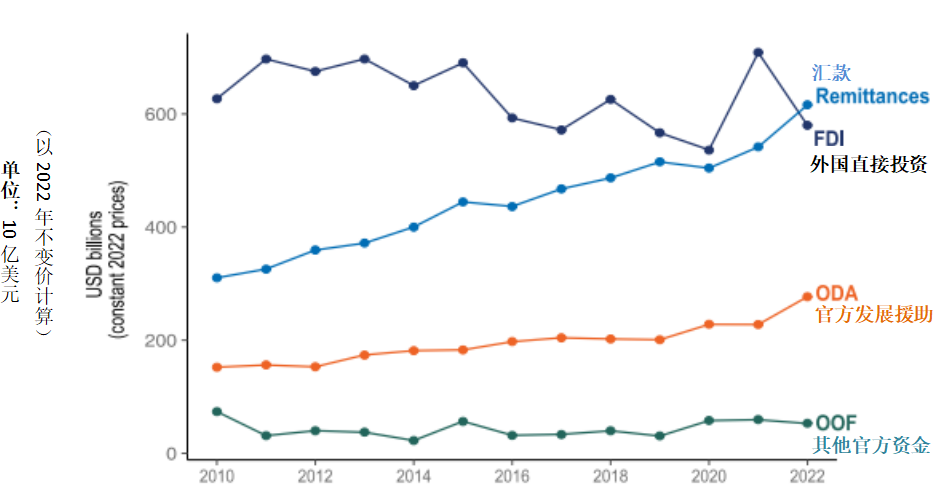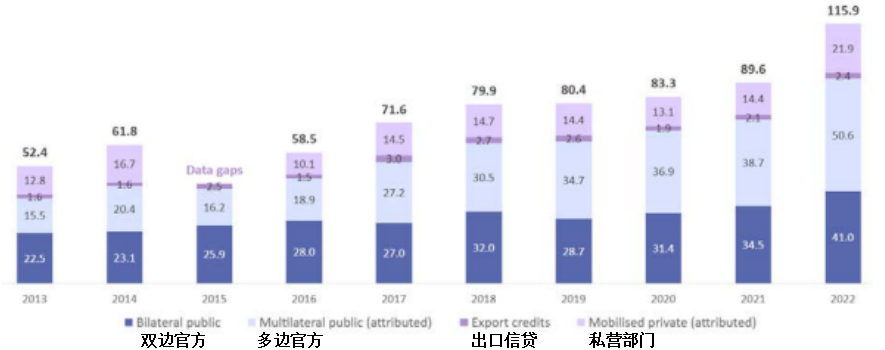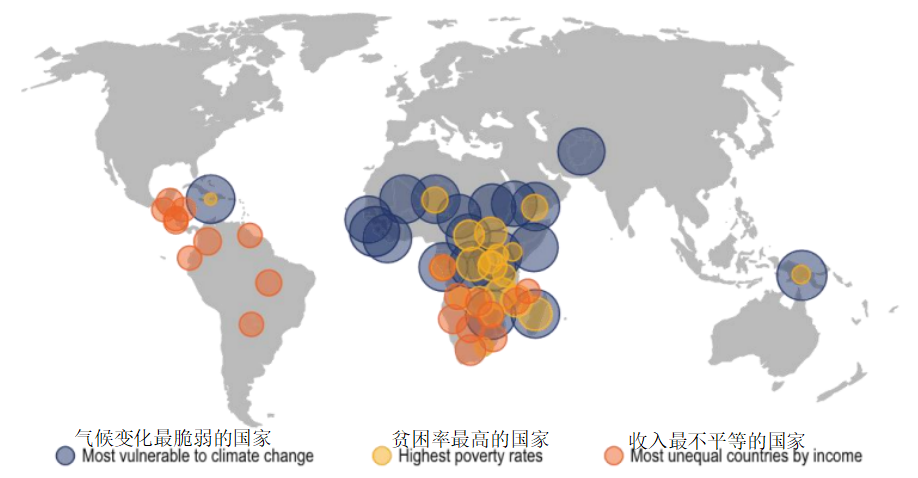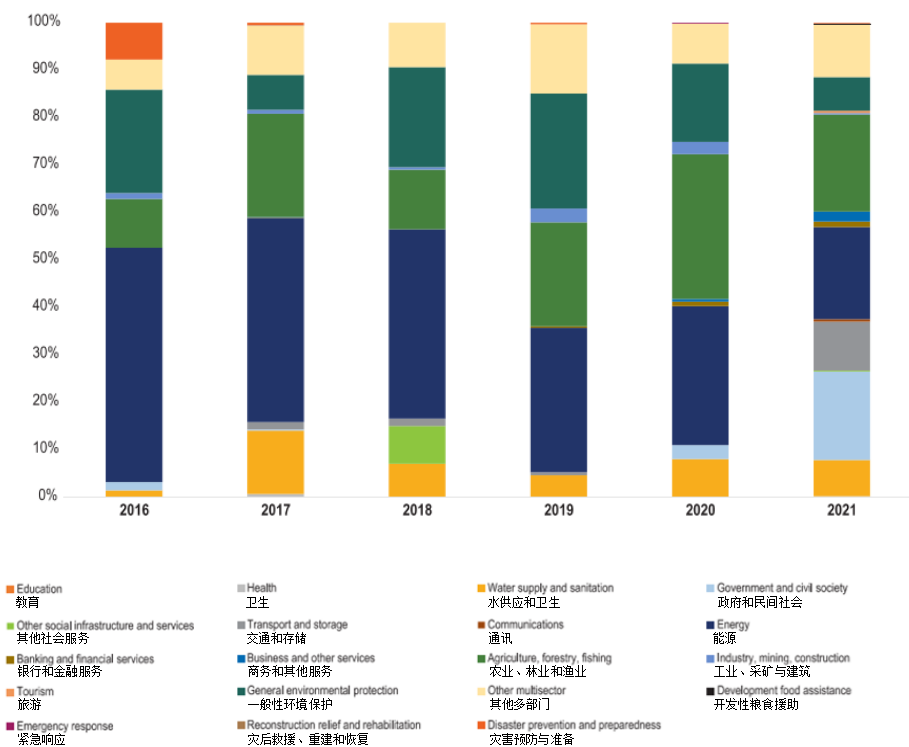author:Li Liping
OECD"2024Development Cooperation Report:What suggestions are put forward to tackle poverty and inequality through green transformation?
2024Year7moon17On 14 July, the Organization for Economic Cooperation and Development (OECD)OECD, hereinafter referred to as the OECD) published the2024Development Cooperation Report (hereinafter referred to as the "Report"). The Report, with the theme of "Addressing Poverty and Inequality through Green Transformation", explains theODA)howAdapting to a rapidly changing worldsituation.The report focuses on the increasingly severePoverty and inequalityandPolicy solutions, highlighting the complex links between poverty, inequality and climate change, and exploring how to leverage green transformation andSynergy to eliminate poverty and reduce inequalityEffectively use official development assistance and climate finance to address challenges in the areas of poverty and inequality and accelerate the achievement of the United Nations Sustainable Development Goals (SDGs).SDG) The goal of “leaving no one behind”. Reported by33ChaptersThink tanks, researchers, development experts, civil society organizations, political leaders andOECD researchteamThe OECD has continuously60The Development Cooperation Annual Report is published in 2017, focusing on one of the most challenging key issues in the field of development cooperation policy and financing, and is a key report for the Development Assistance Committee (DAC).OECD DAC) and international development agencies to provide new perspectives and evidence to promote policy reform, behavior change and the scaling up of best practices.

(OECD/picture)
ODAPoverty and inequality hit new highs but no significant improvement
The report points out that official development assistance funds have2012The company has maintained steady growth over the years and continued to promote sustainable development.2023In 2017, total official development assistance reached2237US$ billion, setting a new record for the fourth consecutive year.2022In 2017, official bilateral and multilateral climate finance also exceeded1000billion commitment to reach1159Billions of dollars.
picture1:2010-2022ODA, other official flows, foreign direct investment and remittances to low- and middle-income countries in 2018

Despite the record-breaking funding, significant improvements in poverty and inequality have not been achieved. The report points out that the number of people living in extreme poverty is currently7100 million people, according to current trends,2030There will still be7%population (approx.5.75billion people live in extreme poverty, while climate change is expected to cause an additional1.32This situation has forced the international community to refocus on the goals of poverty eradication and reducing inequality.2023Year,OECDCouncil of MinistersReaffirming commitment to the Sustainable Development Goals,in particularsustainable development goals11(existglobal challenges.eradicate poverty in all its forms) andsustainable development goals10(Reducing inequality)In the same year, the OECD Development Assistance CommitteeHigh-level meetingRenewal of commitmentComprehensive measures will be takenAddressing these key challenges.also,2024YearUnited NationsHigh-level Political Forum and Brazil G20 (G20)The meeting also actively mobilized all partiesSupport and commitment, striving to accelerate globalAction to address poverty and inequalityprocess.
picture2:2013-2022Climate finance to developing countries, in:10100 million US dollars

Source: OECD,2013-2022Climate finance provided and mobilized by developed countries in 2018
Official development assistance is insufficient in areas of poverty and inequality
2024Year2moon,OECDThe Secretariat has for the first timeOECD Development Assistance Committee (OECD-DAC)Member StateshowTackling poverty and inequality in development cooperationThe problem unfoldedSurvey. Survey resultsshow, member states generally regard reducing poverty and inequality as the core of their development cooperation policiesTarget.24of the member countrieshave19indivualThe country willReducing poverty and inequalityRelevant commitments includedPolicies and laws.However, most member states do not monitor the actual use of ODA in poverty and inequality, nor do they have a common methodology to guide the allocation of ODA.Common methods for measuring official development assistance (ODA) contributions to poverty and inequality,including official development assistance flows to the least developed countries (LDCs) ratio, national project aid (CPA) in different income countries, and the proportion of official development assistance flowing into basic education, health and hygiene, water supply, basic social services, developmental food aid and other poverty reduction indicators of the Sustainable Development Goals (SDG1.a.1The report believes that the existing measurement indicators lack systematicity and cannot fully reveal whether official development assistance really reaches the regions and people who need support most.
To make up for the limitations of existing measurement methods, the report proposes a more detailed and systematic indicator system (focusing on multiple dimensions, including per capita official development assistance of countries with different income levels, areas related to poverty reduction and inequality, climate change, and local investment in various countries) to more comprehensively assess the investment and effect of official development assistance in reducing poverty and inequality. The analysis results are as follows:
Per capita ODA allocations to the extremely poor have fallen.Data shows that2022YearAbove averageIncome countries(UMICs)Extremely poor peopleper capitaThe least developed countries (LDCs) receive the most official development assistanceLDCs) Extremely poor peopleper capitaOfficial development assistance3times, andLower middle incomenation(LMICs) Extremely poor peopleper capitaOfficial development assistance is also higher thanLeast Developed Countries (LDCs)High1.3times. This trend is consistent with2012In stark contrast,Least Developed Countriesper capita official development assistance for the extremely poor is higher thanLower middle-income countriesandUpper middle-income countries.
This distribution shift is mainly caused by two reasons:First,Prioritization of crisis response.2022Ukraine (Lower middle-income countries) received a large amount of official development assistance due to the war, breaking the traditional aid pattern.Second,The differences in the impact of the epidemic.COVID-19epidemicOfback, the least developed countriesof the population living in extreme poverty has increased16%,andLower middle-income countriesandUpper middle-income countriesof people living in extreme povertybutRespectively reduced31%and78%However, ODA allocations have notabletimelyresponseTo more effectively target the countries and populations most in need of assistance, the report recommendsAdjustmentofficial development assistancedistribute, for exampleAbove averagecut official development assistance to high-income countries by two thirds and redirect these resources toLeast Developed Countries.
Resource investment in key areas of poverty reduction is relatively low.Food security, justice, poverty reductionand other entitiesBasic social services and social securityBothKey Poverty-Related Areas.2022Year,These four areasOfficial development assistance receivedOnlyOECDTotal bilateral official development assistance from member countries19.5%,Compared toThe importance of these areas to poverty reductionSignificantly low.existFood security and poverty reduction,In terms of extreme poverty per capita, low-income countries (LICs) received more official development assistance in these two areas than middle-income countries (MICs).existJustice and social security,official development assistanceMore inclined to support middle-income countries.thisIt shows that official development assistance needs to be more tilted towards low-income countries and increase investment in key areas.
Insufficient resources are invested in areas of inequality.Social security, justice, gender equality and women's empowerment, etc.yesKey areas for reducing inequality.2019-2020Year,social SecurityThe proportion of official development assistance has increased from0.6%Increase to1.6%,butOfficial development assistance in2020-2022YearperiodIt has decreased by nearly one-third and although it is higher than the pre-epidemic level, it shows volatility due to insufficient support.judicialfieldofficial development assistanceThe proportion has decreased year by year.2012Year3.3%Down to2022Year1.4%.Gender equality and women's empowermentfieldofficial development assistanceThe proportion from2019-2020Year45%Down to2021-2022Year43%Overall, despite the initial investment in social securityenterThere has been some improvement, but efforts to systemically address inequality remain insufficient.
Climate Changeofficial development assistanceThe poorest and most vulnerable groups are not effectively reached.2019-2022Year,rightClimate Mitigation and AdaptationofThe distribution ratio of official development assistance is becoming more balanced.2021-2022Year,Upper middle-income countriesof people living in extreme povertyObtained climateadaptRelatedAid isLeast Developed Countriesof5times, andLower middle-income countriesThe per capita assistance to the extremely poor is also slightly higher thanLeast Developed Countries.This shows that upper-middle-income countriesandLower-middle-income countries areReceived more assistance, while the least developed countries, especially their poorest and most vulnerable groups, are affected by their weaker adaptive capacity.Climate ChangeThe impact is more severe.
placeLevel datainsufficient.Currently, data on official development assistance allocations are mostly concentrated at the country level, making it difficult to assess whether aid is actually reaching the poorest and most vulnerable groups in the country.placeThe insufficient coverage and reliability of data at the national level also make it difficult to provide a basis for precise policy making.
The above data show that official development assistance resources are gradually dispersed to deal with multiple global crises, and insufficient investment is made in the areas of poverty and inequality. In the future, optimizing the allocation of official development assistance needs to focus on the poorest regions and the most vulnerable groups. Even with limited resources, exploring more efficient allocation methods is an important way to reduce global poverty and inequality.path.
Climate change is deeply linked to poverty and inequality
《Report》Point out thatThe climate crisis is deeply intertwined with poverty and inequality, and is exacerbating where they intersect.46There are approximately11With a population of 1.1 billion, these countries have made negligible contributions to carbon dioxide emissions, but in the past50In the year, there are69%As mentioned above, the impacts of climate change will further exacerbate poverty and inequality, and it is expected that by2030Years lead to additional1.321 billion people fall into extreme poverty. Green transformation is imperative, but the transformation process also has negative effects. For example, in the moderately promoted energy transformation, if there is a lack of supportive socio-economic policies, highly polluting and intensive industries may cause a large-scale employment crisis, and it is estimated that nearly7800Millions of jobs could be lost, while regional and gender inequalities could be exacerbated.
picture3:2022The highest annual poverty rates, income inequality rates, and climate vulnerability20High concentration of countries

Source: OECD,2024Development Cooperation Report
In the process of green transformation, developing countries face more challenges in addressing poverty and inequality. These countries need to not only achieve climate mitigation and adaptation goals, but also balance social and economic development needs. Climate adaptation faces high costs, and the actual demand is currently the amount of adaptation financing.10to18At the same time, more than half of low-income and middle-income countries are already at or close to high debt stress, which has led to cuts in public budgets and further caused serious shortages in funds for public services and social security.2024Average net interest payments as a share of government revenue in low-income and middle-income countries in 20188%The poorest countries urgently need new sources of financing to fill these funding gaps.
Growth in climate finance not flowing to where it’s needed most
The scale of climate finance has grown steadily in recent years.2016to2021Between 2006 and 2010, the total financing of the four major climate funds, namely, the Adaptation Fund, the Climate Investment Fund, the Green Climate Fund and the Global Environment Fund, increased from27US$ billion39100 million US dollars.However,climateFunding does not adequately reach the areas that need support most.about75%ofDevelopingCountries should include in their nationally determined contributions (NDCs) will be agriculture, biodiversity and ecosystems, forestry,healthand water resources as priority areas for adaptation.2016to2021Between 2006 and 2010, the investment of the four major climate funds in the energy sector increased from 1.3% to 2.6% of the total funds.49%Down to19%,rightInvestment in agriculture, forestry and fisheries has increased. However, support for other adaptation areas remains insufficient..supportBiodiversity and Ecosystemsetc. GeneralEnvironmental ProtectionissueThe share of climate finance has increased from2016Year22%Down to2021Year7%.healthAlthough the area is considered a priority for action, climate funds have not yetableSignificantly increase relevant investment. Although the proportion of funds in the water resources field has increased,from2016Year1%Increase to2021Year8%, but the overall scale is still limited.
picture4:2016-21The allocation ratio of the four major climate funds in various fields in 2018 shows that climate funds have failed to focus on the field of adaptation.

Sources:OECD,"2024Development Cooperation Report
Fragmentation of climate finance increases the burden on recipient countries
Climate financeofFragmentation problembigimplementation burden and transaction costs on recipient countries. Climate FinanceThe number of institutions has increased dramatically, while the scale of projects has decreased..Over the past decade,Multilateral development finance70%From10an institution, andThe number of active multilateral institutions has exceeded200The scale of the project is shrinking.Climate Finance ProjectsandDevelopment strategies of recipient countriesOut of touch.2016to2021Between 2000 and 2011, the number of climate finance projects in small island states increased from670Increase to2758The average number of projects per year is1391However, the implementation of these projects is often not linked to the development strategies of the recipient countries, making it difficult to achieve synergy, thus affecting the sustainability of the projects.
《Report》pointed outAligning climate funds with the actual needs and strategies of developing countries and providing funds directly to developing countries is the key to addressing the fragmentation problem. However, this process faces many challenges.First,Developing countries are underrepresented.Developing countries have limited decision-making power in climate funds and find it difficult to dominate resource allocation.Second,Lack of direct execution capabilities.Despite the establishment of the Green Climate FundTime commitmentPromote direct funding to developing country institutions, but2016to2021During the years,Green Climate Fundonlyhave14%ofFunding goes directly to developing countriesofAgency; Adaptation FundThe ratiofor13%, while the Global Environment Fund and Climate Investment Funds have0%.Third,Recipient countriesPossess practical application abilitymechanismQuantities are limited.exist62indivualApplicationAmong developing country institutions, only20InstitutionssuccessObtained the qualification for project implementation.
Tackling poverty and inequality through green transformation
The report points out thatRising poverty, inequality and climate changeIntertwined and intensifying, providing an opportunity for international development actors——Putting people at the heart of the green transformation while advancing action to reduce poverty, promote equality and address climate change, andAs far as possibleSynergistic effect.To encourage development cooperation providers to support a fair green transition, benefit the poor and the most vulnerable groups, and achieve the goals of poverty reduction and narrowing inequality, the report puts forward three specific recommendations:
First,Strengthening poverty reductionand reduce inequalitymission, committed to eliminating poverty and reducing inequality through precise targeting, clear standards and improved toolkits.Specific recommendations for action include: Institutions should reaffirm their commitment to eliminating monetary and multidimensional poverty,As we address climate change and other priorities,BundleReducing poverty and inequality as a core mission; Systematically integrate poverty and inequality perspectives into development cooperation, clarify the allocation principles of official development assistance, coordinate financing targets, and ensure that financial support is consistent with policy needs to eliminate poverty and reduce inequality.passEstablish clear standards, guidelines and measures,Ensure accurate coverageThe poorest and most vulnerable countries and groups.At the same time, research and evaluation will be carried out to ensure that negative spillover effects are mitigated as much as possible in the implementation of poverty reduction, inequality reduction policies and green transformation.
Second, increase the official development assistance budget, strengthen the coordination between development and climate finance, and improve the accessibility and effectiveness of financing..Specific action recommendations include: Member States must fulfill their obligation to0.7%Asofficial development assistanceinternational commitments and increase the proportion of funding targeting poverty and inequality in the overall budget;Reduce developing countriesRestrictions on access to funds,likeEliminate co-financing requirements, enhance project planning capabilities, and simplify funding application processes;Improving access to and delivery of climate funds,Reduce fragmentation and duplication of development finance and ensure funds are used more efficientlytouchRegions that need support; expand loan guarantees for clean energy projects, promote regional cooperation, provide technical assistance, and enhance the renewable energy development capabilities of partner countries;Nationally determined contributions serve as a strategic tool to link climate action and development goals, supportinghost countryexistPrepare newOne roundNationally Determined ContributionsplanhourIntegrate a poverty and inequality perspective to ensure that climate action takes social equity into account.
Third,Advocating for an inclusive and rights-based green transition, improve public acceptance of green transformation and enhance the resilience and sustainability of the transformation.Specific action recommendations include: establishing inclusive partnerships, strengthening the broad participation of local communities in the implementation of green transformation projects, and supporting community capacity building; monitoring environmental impacts and conducting gender analysis in nationally determined contribution plans and energy transformation projects;Comply with international laws, standards and recommendations, such asOECDCode of Responsible Business Conduct,make surePartnerships andfundMedium protectionRelatedrights and interests;Integrate global climate justice considerations into national development strategies and mechanisms,positiveManaging climate action maybringnegative cross-border impacts.
Thinking: The challenge of turning the report's recommendations into action
Although poverty and inequality have long been discussed on the global development agenda, this is by no means"It is not a commonplace, but a key bottleneck for sustainable development of the global economy, society and environment. The report puts forward a series of specific recommendations, including how to optimize the allocation of official development assistance funds and how to make climate finance more effectively benefit the most vulnerable countries and people. HoweverOECDThe real test for the United Nations and other international development partners is how to translate these recommendations into practical action.
Although the total amount of official development assistance has maintained a steady growth in recent years, the increase is far less than the actual demand.OECDThe economic weakness of the member countries makes it difficult for most countries to fulfill theirGNIof0.7%International commitments for development aid. With limited resources, donors often need to make trade-offs among multiple priorities, which can weaken financial support and policy attention to areas of poverty and inequality.
Official development assistance (ODA) is not only a key resource for development cooperation, but has also long been part of the foreign policy tools of donor countries, serving their political, economic or geostrategic interests. To maintain ODA's focus on poverty and inequality, it is necessary to re-examine its institutional design, accurately balance crisis response and long-term development needs, and ensure that aid is effectively targeted at key areas, countries and groups.
There is still much room for improvement in climate finance in promoting adaptation investment and coordinating with poverty reduction and inequality reduction strategies.Climate FundMake systemic changes from allocation to execution mode to betterlandMeeting the actual needs of partner countries. However, this cannot be achieved overnight and needs to be achieved gradually through continuous dialogue and joint efforts among donor countries, development implementation agencies, Southern countries and civil society.
It is worth noting that this edition of the report includes opinion articles from experts from South-South cooperation countries such as China, Brazil, Indonesia, and Bangladesh. This move shows that in the context of green transformation, the Sustainable Development Goals (SDGs) should be integrated into theSDGs) back on track, the OECD Development Assistance CommitteeNeed to strengthen cooperation with South-South partners,By sharing resources and experience, listening to each other and learning from each other, we will build a more inclusive and open cooperation model and inject new vitality into global development cooperation.
(The author has worked for UN agencies and international foundations and is currently a philanthropy and international development consultant.)
References
https://www.oecd.org/en/publications/development-co-operation-report-2024_357b63f7-en.html

All rights reserved, please indicate the source when citing.
